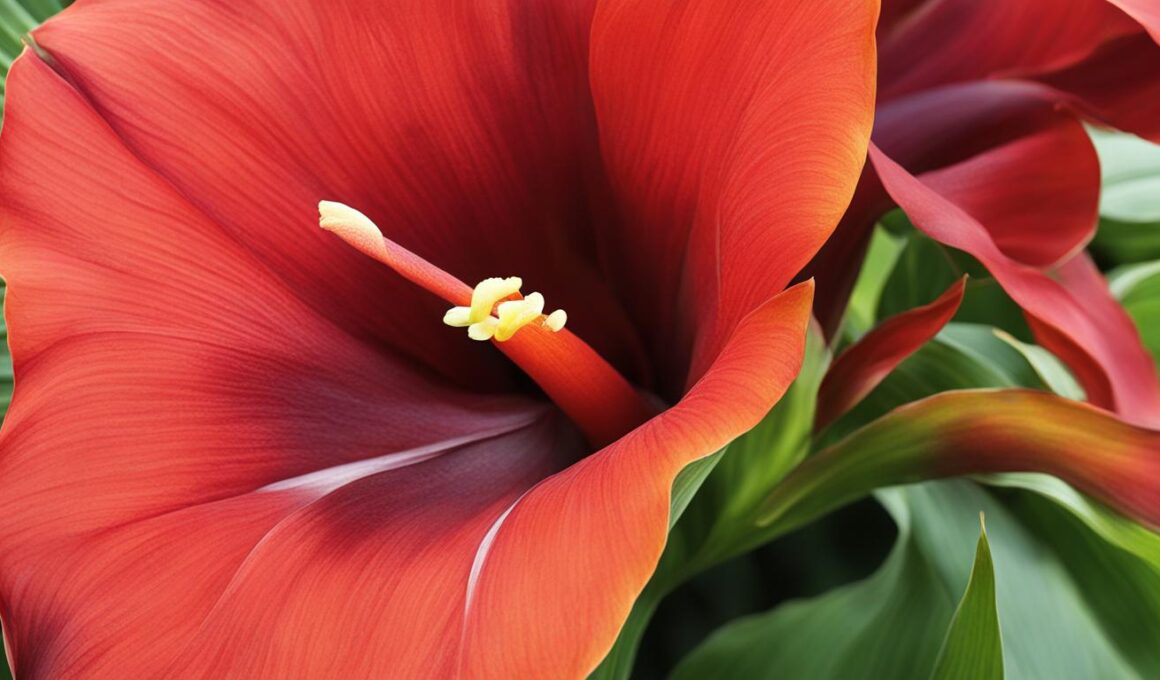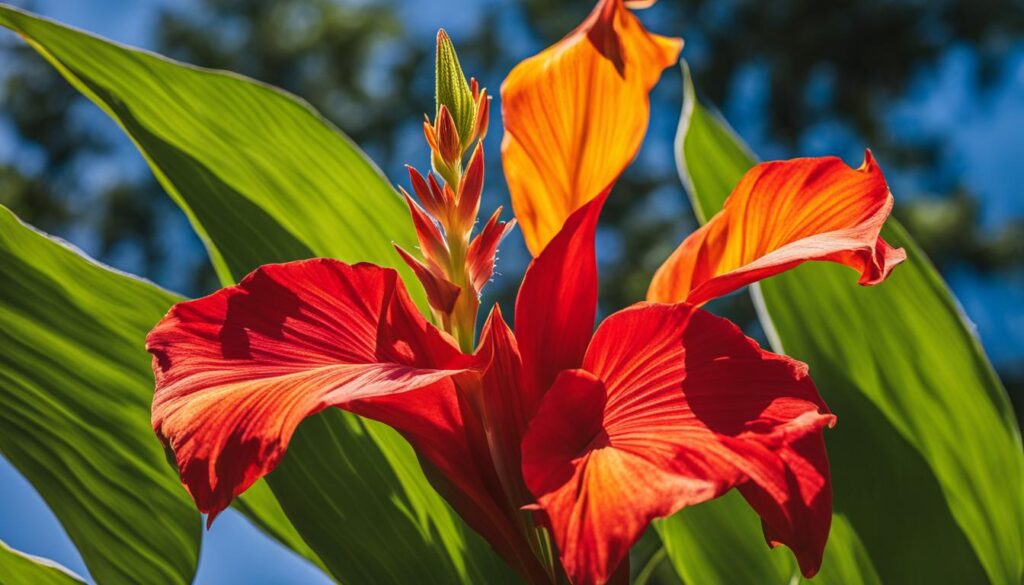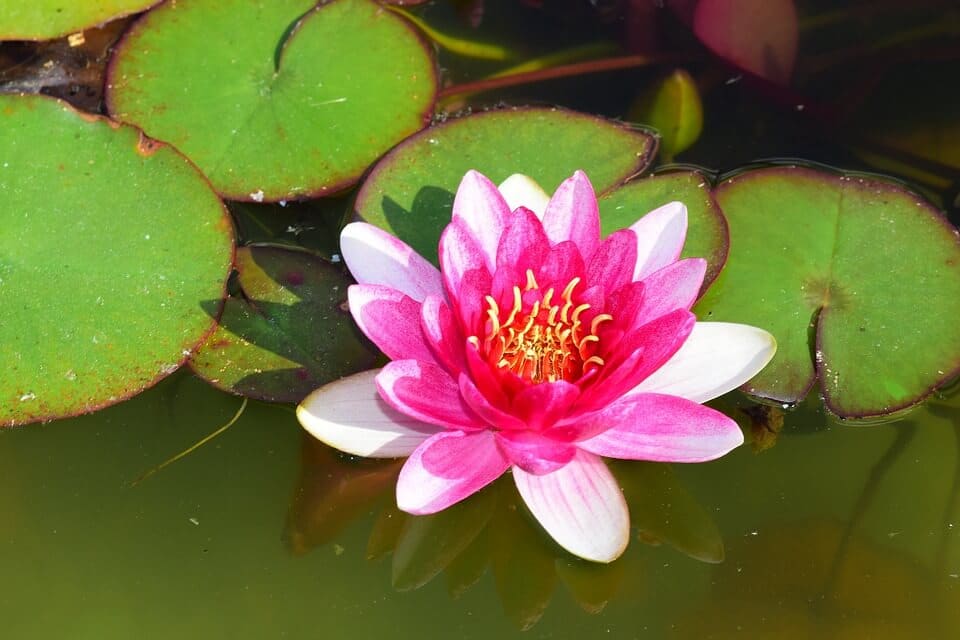The canna lily and calla lily are two popular plant species that are often confused due to their similar names and appearances. However, they belong to different families and have distinct characteristics. In this article, we will explore the differences between canna lilies and calla lilies, as well as provide tips for growing and caring for each in your garden. Whether you prefer the vibrant, tropical flair of the canna lily or the elegant charm of the calla lily, understanding their unique features will help you choose the ideal plant for your garden.
Key Takeaways:
- Canna lilies and calla lilies belong to different families and have distinct characteristics.
- Canna lilies are known for their large, paddle-shaped leaves and vibrant flowers, while calla lilies have slender stems and elegant trumpet-shaped flowers.
- Canna lilies are easier to care for and more drought-tolerant compared to calla lilies.
- Understanding the differences between canna lilies and calla lilies will help you choose the ideal plant for your garden.
- Both canna lilies and calla lilies add beauty and charm to any garden.
Canna Lily (Canna spp.)
The Canna Lily, scientifically known as Canna spp., is a stunning plant belonging to the Cannaceae family. Native to tropical and subtropical regions, this rhizomatous perennial plant is beloved for its vibrant and exotic appearance. The Canna Lily features large, paddle-shaped leaves that add a lush and tropical feel to any garden. These leaves come in various shades of green and often have distinctive markings, enhancing their visual appeal.
One of the most striking features of the Canna Lily is its vibrant and showy flowers. The Canna Lily produces flowers in a wide array of colors, including shades of red, orange, yellow, and pink. These flowers are often large and bold, creating a dramatic display in gardens and landscapes. With a height that can reach up to 6 feet, the Canna Lily becomes a focal point in any outdoor space, adding a touch of tropical elegance.
To successfully grow and care for Canna Lilies, it is important to provide them with the right conditions. These plants thrive in full sunlight, preferably receiving at least six hours of direct sunlight each day. Adequate sunlight ensures healthy growth and promotes the development of vibrant flowers. Additionally, Canna Lilies require regular watering to keep the soil consistently moist. However, it is crucial to avoid overwatering, as excessive moisture can lead to root rot. Well-drained soil is essential to prevent standing water and maintain the plant’s overall health.
Growing and Care Tips for Canna Lilies:
- Plant Canna Lilies in a location that receives full sunlight for at least six hours a day.
- Ensure the soil is well-drained to prevent waterlogging and root rot.
- Water the plants regularly to keep the soil consistently moist, but avoid overwatering.
- Apply a balanced fertilizer during the growing season to promote healthy growth and flowering.
- Remove faded flowers to encourage continuous blooming.
- Protect Canna Lilies from frost during winter by covering them or storing the rhizomes in a cool, dry place.
By following these care tips and providing the right growing conditions, you can enjoy the beauty and splendor of Canna Lilies in your garden. These tropical and vibrant plants will undoubtedly add a touch of exotic charm to your outdoor space.
Calla Lily (Zantedeschia spp.)
The Calla Lily, scientifically known as Zantedeschia spp., is a beautiful flowering plant that belongs to the Araceae family. Native to South Africa, the Calla Lily is renowned for its trumpet-shaped flowers, which come in a wide range of colors. From the classic white and elegant pink to vibrant purple, yellow, and orange, Calla Lilies offer a stunning display of hues. The flowers are complemented by slender stems and long, arrow-shaped leaves, adding to the plant’s overall grace and charm.
When it comes to growing and caring for Calla Lilies, there are specific conditions to consider. These plants prefer partial shade, making them an excellent choice for gardens with filtered sunlight. Additionally, well-drained soil is essential for the optimal growth of Calla Lilies. It is vital to avoid overwatering, as these plants are susceptible to root rot. Adequate spacing between the plants is recommended to promote proper air circulation and reduce the risk of fungal diseases.
Calla Lilies can be a breathtaking addition to any garden or floral arrangement. Their unique shape and vibrant colors make them a popular choice for weddings and special occasions. With careful attention to their preferred growing conditions, you can enjoy the beauty of Calla Lilies and create a captivating display in your outdoor space.
Key Features of Calla Lilies:
- Belongs to the Araceae family
- Native to South Africa
- Trumpet-shaped flowers in various colors
- Slender stems and long, arrow-shaped leaves
- Prefer partial shade and well-drained soil
Key Differences Between Canna Lily and Calla Lily
Although canna lilies and calla lilies may share similar names and appearances, there are several key differences between these two plant species. Understanding these distinctions will help you make an informed decision when choosing the ideal plant for your garden.
Appearance
One of the most noticeable differences between canna lilies and calla lilies is their appearance. Canna lilies are larger in size, with banana-shaped leaves and showier flowers in vibrant shades of red, orange, yellow, and pink. On the other hand, calla lilies have smaller, more slender leaves and produce subtle white or pale pink flowers with a distinct trumpet shape.
Maintenance
When it comes to maintenance, canna lilies are generally easier to care for and more drought-tolerant than calla lilies. Canna lilies require less water and attention, making them a low-maintenance option for busy gardeners. Calla lilies, on the other hand, need more water and specific care conditions, including partial shade and well-drained soil.
Hardiness, Growing Conditions, and Lifespan
The hardiness, growing conditions, and lifespan of canna lilies and calla lilies also differ. Canna lilies are hardy in USDA zones 7 to 11 and thrive in full sun to partial shade. They prefer moist soil and can withstand hot temperatures. Calla lilies, on the other hand, are hardy in USDA zones 8 to 10 and prefer partial shade. They require well-drained soil and are more sensitive to temperature changes. In terms of lifespan, canna lilies are generally perennials and can last for several years, while calla lilies are typically grown as annuals or lifted and stored over winter.
Price is another factor to consider when choosing between canna lilies and calla lilies. Due to their larger size and showier flowers, canna lilies are often more expensive than calla lilies. However, the price may vary depending on the variety and availability in your area. It’s always a good idea to check with local nurseries or online suppliers for the most accurate pricing information.
In summary, while both canna lilies and calla lilies can add beauty to your garden, they have distinct differences in terms of appearance, maintenance, hardiness, growing conditions, and price. Consider these factors and your personal preferences when selecting the ideal plant for your outdoor space.
What are the key differences between Canna Lily and Calla Lily plants when it comes to growing a garden?
When aiming to grow gorgeous gardens with canna lily and calla lily plants, it’s crucial to note the distinctions. Canna lilies typically require full sun and ample water, while calla lilies thrive in partially shaded areas with moist soil. Canna lilies also tend to have larger, more vibrant leaves compared to calla lilies.
Conclusion
The canna lily and calla lily may have similar names and appearances, but they possess distinct characteristics that set them apart. By understanding the differences between these two plant species and their specific care requirements, you can make an informed decision when choosing the ideal plant for your garden. Whether you prefer the vibrant beauty of the canna lily or the subtle elegance of the calla lily, both options promise to add a touch of splendor to your outdoor space.
FAQ
What is the difference between a canna lily and a calla lily?
Canna lilies and calla lilies belong to different families and have distinct characteristics. Canna lilies have large, paddle-shaped leaves and showier flowers in shades of red, orange, yellow, and pink. Calla lilies, on the other hand, have slender stems, long arrow-shaped leaves, and elegant trumpet-shaped flowers that come in various colors.
Which family does the canna lily belong to?
The canna lily belongs to the Cannaceae family.
Where are calla lilies native to?
Calla lilies are native to South Africa.
How tall can canna lilies grow?
Canna lilies can reach a height of up to 6 feet.
What are the preferred growing conditions for canna lilies?
Canna lilies prefer tropical and subtropical regions, as well as full sun and well-drained soil.
How tall can calla lilies grow?
Calla lilies can grow up to 3 feet tall.
What type of soil do calla lilies prefer?
Calla lilies prefer well-drained soil.
Which lily is easier to care for?
Canna lilies are generally easier to care for and more drought-tolerant compared to calla lilies.
What are the differences in appearance between canna lilies and calla lilies?
Canna lilies have larger banana-shaped leaves and showier flowers, while calla lilies have smaller, more slender leaves and subtle white or pale pink flowers.
What are the key differences between canna lilies and calla lilies?
The key differences include maintenance, appearance, hardiness, growing conditions, price, and lifespan.












